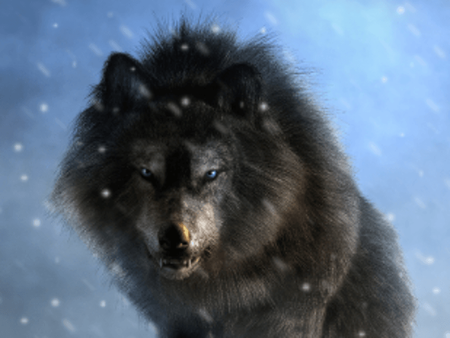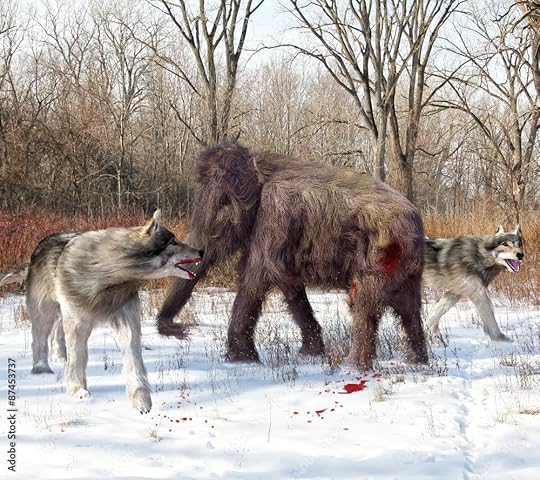Dire Wolf

A dire wolf is a large wolf, usually portrayed as a larger, more intelligent, and more vicious version of a regular wolf. Dire wolves are typically depicted as black or dark grey. Some stories say that dire wolves are wolves that have been brought back from the grave to hunt.

In some stories, Dire wolves are macabre parodies of living wolves. They are similar to Hell Hounds with tattered flesh clinging to crackling bones, preying on farms and villages. But what inspired these incredible beasts?
In Norse mythology, Fenrir was a giant wolf bound by Odin. He was destined to grow too large for his chains and kill his captor. When Fenrir grew large enough that his jaws could cover the expanse between the heavens and earth, Fenrir was killed. Some stories claim that Fenrir was a dire wolf.
 Somewhere in Southwestern North America during the late Pleistocene, a pack of dire wolves are feeding on their bison kill, while a pair of grey wolves approach in the hopes of scavenging.
Somewhere in Southwestern North America during the late Pleistocene, a pack of dire wolves are feeding on their bison kill, while a pair of grey wolves approach in the hopes of scavenging.Turns out, you don’t have to look far. Dire wolves are creatures that actually existed a long time ago. Since their discovery in 1854, many have placed the dire wolf in a grossly over-exaggerated category of monstrous saber-toothed, green eyed demons. However, these animals were not far from the wolves we know today.

Canis diris – meaning fearsome dog roamed North and South America during the late Pleistocene (approx. 40,000 – 10,000 years ago). The average dire wolf appears to have been roughly the same height as a modern gray wolf, but was stockier and had larger teeth. On average, a dire wolf would weigh around 70 lbs more.
Based on the musculature, researchers have calculated that the bite force of a dire wolf would have 128% more powerful than a modern wolf. The braincase is smaller meaning the wolf would have been less intelligent than their relatives.
The domestication of a real dire wolf 15,000 years ago was likely impossible. Modern wolves prove to be largely shy, unpredictable and aggressive despite attempts at domestication. The smaller-brained dire wolf, if it was anything like its modern counterparts, would not have responded well to human training, would have been extremely dangerous

The real dire wolves became extinct about 10,000 years ago, along with most other North American megafauna. One theory links their extinction to the demise of the large, slow prey animals such as mastodons or giant sloths at the end of the Pleistocene. The faster modern gray wolf was able to survive hunting the faster animals.

More than 4,000 dire wolves have been excavated from the La Brea Tar Pits in Los Angeles. Dire wolves have always been an iconic representation of the last Ice Age and have inspired the myths that populate many fantasies including A Song of Ice and Fire and Warhammer.
Sources:
Dire wolf mythology. Dire Wolf Mythology | Dire Wolf Project. (n.d.). Retrieved June 22, 2022, from https://direwolfproject.com/dire-wolf/dire-wolf-mythology/#:~:text=Ever%20since%20their%20discovery%20in,creature%20that%20ruled%20prehistoric%20history.
Haddock, G. (2005, June 1). Dire Wolf. Mythical and fantasy creatures. Retrieved June 22, 2022, from http://www.mythcreatures.co.uk/beasts/direwolf.asp
Preston, R. E. (2015, October 30). Direwolves: Real and George R. R. Martin-Imagined. Winter is Coming. Retrieved June 22, 2022, from https://winteriscoming.net/2015/10/30/direwolves-real-george-r-r-martin-imagined/
Warhammer Armies: Vampire Counts (8th Edition)
Wolpert, S. (2021, January 13). The dire wolf was a distinct species, different from the gray wolf, biologists discover. UCLA. Retrieved June 22, 2022, from https://newsroom.ucla.edu/releases/prehistoric-dire-wolf-was-a-distinct-species#:~:text=More%20than%204%2C000%20dire%20wolves,have%20survived%20until%20this%20day.



